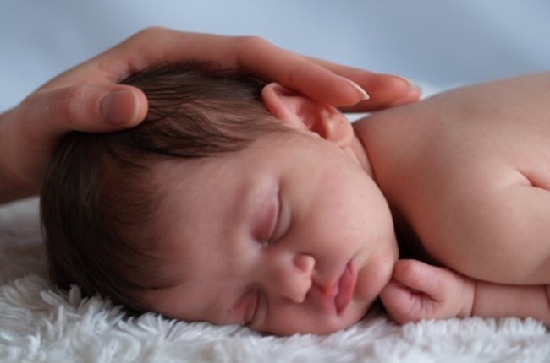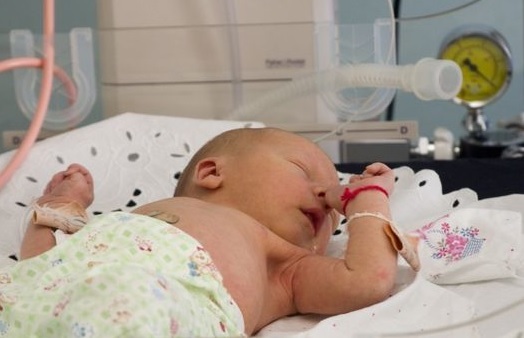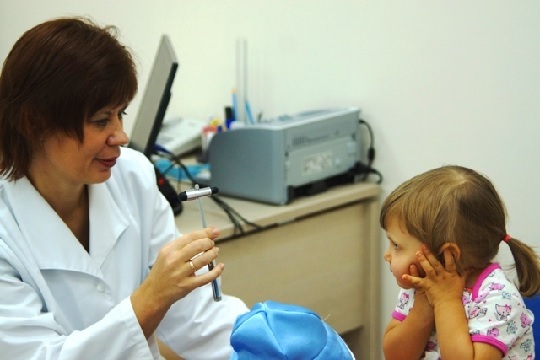Features of manifestations and consequences of cerebral hemorrhage in newborns
Contents:
- Risk factors for cerebral hemorrhage
- Types of cerebral hemorrhage
- Principles of therapy and possible complications
 Birth of a baby belongs to the responsible tasks, especially if the pregnancy has been taking place with complications. The risks of damage to blood vessels, fetal nervous system cause fear in future parents. Let's consider why the pathology arises, how it manifests itself and how the hemorrhage in the brain threatens in preterm infants and children born on time.
Birth of a baby belongs to the responsible tasks, especially if the pregnancy has been taking place with complications. The risks of damage to blood vessels, fetal nervous system cause fear in future parents. Let's consider why the pathology arises, how it manifests itself and how the hemorrhage in the brain threatens in preterm infants and children born on time.
Risk factors for cerebral hemorrhage
Causes of cerebral hemorrhage in newborns have their own characteristics, depending on the maturity and fidelity of the fetus. The basic provoking factors include:
- premature birth in a future mother with a period of 31 weeks or less, especially with late toxicosis;
- pathological course of labor - rapid or prolonged( hypoxia of the brain in the fetus);
- mismatch of fetal dimensions, maternal pathways of the mother - a large baby with a large head in a woman with a borderline with a normal pelvic size, or an average fetus with a narrow pelvis;
- obstetric manipulations( obstetric forceps, use of vacuum extraction);
- a pregnant pregnancy - the seams between the bones of the skull lose plasticity, become obstinate, increasing the likelihood of trauma;
- intrauterine infections;
- vascular malformations or clotting disorders in the fetus.
The most critical moment is the time of increased risk, it is the first 7 days when the characteristic manifestations are revealed. They appear suddenly, mainly during wakefulness. If the damage does not occur, from the second week of life the prognosis becomes favorable.
Important! In a premature and immature toddler, the possibility of trauma in childbirth with subsequent hemorrhage is very high - observed in 50% of children weighing less than 1500 g.
. Types of cerebral hemorrhages
. The initial symptoms of brain hemorrhage in the child , are almost identical in the majority:
- impaired consciousness, lethargy;
- periods show increased excitability, excessive reaction to a minimal stimulus;
- crying, frequent screaming;
- bulging of the fontanelle or enlargement of the head circumference due to accumulation of blood in certain places;
- head pain, increased intracranial pressure;
- poor appetite and weight loss;
- convulsions and regurgitation( vomiting).
Important! Additional signs differ depending on the location of the damage, allow to establish its exact location.
Intracranial hemorrhage in a newborn is classified into subspecies:
- Epidural - associated with the vessels directly under the bones of the skull, above the medullary membranes. Pathology occurs when the development of cranial plates, a delayed pregnancy in rapid delivery, is incorrect. Distinctive manifestations include: a drop in pressure, a decrease in the pulse, the baby suffocates, has unequal pupils - expanded on the injured side. After birth, there is a period of calm( from 3 to 6 hours), turning into a syndrome of compression of the brain, deterioration of the state with the transition to a coma after 2-3 days.
- Subdural - blood accumulates between the hard and soft medulla. Often occurs in women with a mismatch in the size of the fetus, pelvic index. The child has muscular hypotension, weak reflexes, convulsions. It occurs rarely, but with delayed treatment, it threatens with neurological disorders.
- Subarachnoid - more typical for premature babies, when using obstetric manipulations. There is a defeat of the vessels under the membranes, over the substance of the brain. There are symptoms: sleep disturbance, excessive excitability, frequent crying, neck tension, strabismus, prolonged wakefulness with open eyes, it is unnatural for children to have an unsettling face. However, it has the most favorable forecast.
- Hemorrhage in the ventricles of the brain in newborns occurs in the first 3 days in children born with deep prematurity. They are referred to the most dangerous pathology with massive damages - muscle hypotension, weak vital reflexes, periodic respiratory arrest, coma development, cerebral palsy with inadequate therapy or its absence.
Principles of therapy and possible complications of
 It is important that the treatment of cerebral hemorrhage in the neonatal brain is adequate and complex. There are following principles of therapy:
It is important that the treatment of cerebral hemorrhage in the neonatal brain is adequate and complex. There are following principles of therapy:
- provide oxygenation - the supply of the required level of oxygen to brain cells;
- normalize blood circulation, stabilize the pulse, pressure, avoiding their jumps;
- control of blood coagulation indicators;
- anticonvulsant and symptomatic therapy;
- gentle, gentle mode;
- possible surgical treatment in term infants.
The consequences of cerebral hemorrhage in the newborn have a wide range and depend on the extent of damage to the brain structures, quality, timeliness of treatment, maturity of the baby and the diligence of the parents. Possible manifestations include:
- neurological disorders, paresis;
- hydrocephalus and developmental lag;
- cerebral palsy.
The consequences of cerebral hemorrhage in prematurity have a more serious prognosis for significant lesions. Risks at localized( I-II degree) hemorrhages are equal to those of full-term children.
The organism of each small patient is individual and at qualitative treatment, love and care from the first minutes can overcome any difficulties and in due course does not differ from healthy coevals.
write the question in the form below:



